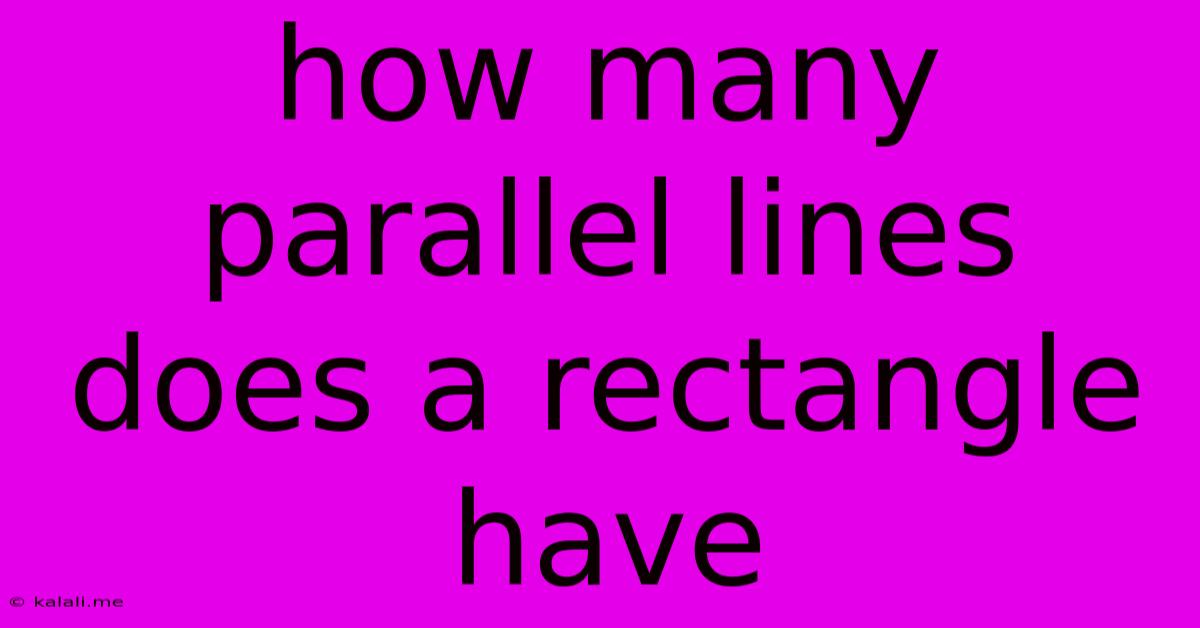How Many Parallel Lines Does A Rectangle Have
Kalali
May 09, 2025 · 2 min read

Table of Contents
How Many Parallel Lines Does a Rectangle Have? A Geometry Deep Dive
A rectangle, a fundamental shape in geometry, is defined by its properties. Understanding these properties, particularly concerning parallel lines, is crucial for grasping its geometrical significance. This article will explore the number of parallel lines in a rectangle, clarifying any potential confusion. The answer might seem simple at first glance, but we'll delve deeper into the underlying concepts.
What is a Rectangle?
Before jumping into parallel lines, let's refresh our understanding of rectangles. A rectangle is a quadrilateral, meaning it's a two-dimensional shape with four sides. Crucially, a rectangle has four right angles (90-degree angles) and its opposite sides are equal in length and parallel to each other. This parallelism is the key to answering our main question.
Identifying Parallel Lines in a Rectangle
A rectangle possesses two pairs of parallel lines. Let's break this down:
- Pair 1: The two longer sides (often called the length) are parallel to each other. They never intersect, no matter how far they are extended.
- Pair 2: The two shorter sides (often called the width) are also parallel to each other. Similarly, they never intersect, regardless of extension.
Therefore, a rectangle has a total of four lines, organized into two distinct parallel pairs. This parallel property is what distinguishes a rectangle from other quadrilaterals like trapezoids or parallelograms (though parallelograms also have parallel sides).
Beyond the Basics: Understanding Parallelism in Geometry
The concept of parallel lines is fundamental in geometry and extends far beyond simply identifying them in rectangles. Parallel lines are crucial in various geometric proofs and constructions. Understanding parallelism allows us to:
- Calculate areas and perimeters: The parallel nature of a rectangle's sides simplifies area and perimeter calculations.
- Construct more complex shapes: Parallel lines are building blocks for more intricate shapes and geometric designs.
- Apply geometric theorems: Many geometric theorems rely on the properties of parallel lines.
Distinguishing Rectangles from Other Quadrilaterals
It's essential to differentiate rectangles from other quadrilaterals. While a square is a special type of rectangle (all sides equal), other quadrilaterals like parallelograms have parallel sides but lack the right angles defining a rectangle. Trapezoids, on the other hand, only have one pair of parallel sides. Understanding these distinctions is key to mastering geometry.
Conclusion: The Answer and its Implications
In conclusion, a rectangle has two pairs of parallel lines, totaling four lines in all. This seemingly straightforward answer highlights the fundamental geometrical properties of rectangles, paving the way for a deeper understanding of more complex geometrical concepts and applications. The parallelism in rectangles isn't just a descriptive feature; it's a foundational element in various geometric calculations, proofs, and constructions.
Latest Posts
Latest Posts
-
Least Common Multiple Of 4 And 18
May 09, 2025
-
Which Is A Property Of Acids In Aqueous Solutions
May 09, 2025
-
What Is 15 Out Of 18 As A Percentage
May 09, 2025
-
What Is The Prefix In Mean
May 09, 2025
-
17 Is What Percent Of 80
May 09, 2025
Related Post
Thank you for visiting our website which covers about How Many Parallel Lines Does A Rectangle Have . We hope the information provided has been useful to you. Feel free to contact us if you have any questions or need further assistance. See you next time and don't miss to bookmark.